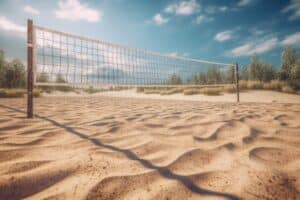Can a volleyball touch the net outside the antenna?
Key Takeaways
- Net contact outside the antenna is considered legal by some sources as long as it does not interfere with the play.
- Other sources argue that any net contact outside the antenna during the action of playing the ball is considered a fault.
- Consulting the specific rules and regulations of the competition is necessary to determine whether net contact outside the antenna is permissible or not.
When it comes to volleyball, there are specific rules and regulations in place to ensure fair play and maintain the integrity of the game. One such rule pertains to whether a volleyball can touch the net outside the antenna. Let’s delve into this topic and explore the different perspectives.
The Argument for Legal Net Contact
According to some sources, it is permissible for a volleyball to touch the net outside the antenna without it being considered a fault. These sources argue that as long as the net contact does not interfere with the play, it is within the boundaries of the game. The official volleyball rules, as stated by the FIVB (International Volleyball Federation), suggest that net contact outside the antenna is legal.
Strength-and-Power-for-Volleyball.com, a reputable source for volleyball-related information, supports this viewpoint. They state that although net contact outside the antenna is allowed, it should not disrupt the flow of the game. This implies that if the net contact does not affect the outcome of the play, it is not considered a violation.
The Argument Against Net Contact
On the contrary, some sources, such as Volley-Pedia.com, argue that any contact with the net by a player outside of the antenna during the action of playing the ball is indeed a fault. They refer to the FIVB 2017-2020 Rule book, which explicitly states that net contact outside the antenna is not legal.
VolleyballBlaze.com supports this viewpoint, claiming that it is considered a violation if a volleyball touches the net outside the antenna. However, it is important to note that there might be some variations in rules and interpretations among different leagues and organizations. It is always advisable to consult the specific rules governing a particular competition.
The Verdict
Based on the available information, it seems that there is a divergence of opinions regarding whether a volleyball can touch the net outside the antenna. While some sources claim it is legal as long as it does not interfere with play, others argue that it is a fault according to the FIVB rule book.
It is worth mentioning that the FIVB rule book is generally regarded as the definitive guide for international volleyball competitions. However, local leagues and organizations may have their own set of rules, which could differ slightly.
Ultimately, to determine whether net contact outside the antenna is permissible or not, it is essential to consult the specific rules and regulations governing the particular competition in question. This will provide a clear understanding of what is considered a violation and what is allowed within the boundaries of the game.
Related Websites:
FAQs:
Q: Can a volleyball touch the net outside the antenna?
Yes, a volleyball can touch the net outside the antenna. However, there are specific scenarios and rules regarding this contact.
Q: What are the dimensions and layout of a standard volleyball court?
A standard volleyball court measures 18 meters long and 9 meters wide. It is divided by a net into two equal halves.
Q: What is the purpose of the antennas in volleyball?
Antennas in volleyball are used to mark the boundaries of the net. They play a vital role in determining if a ball is in or out of play.
Q: What are the rules regarding a volleyball’s contact with the net during gameplay?
According to the rules, a ball can touch the net outside the antennas during gameplay as long as it doesn’t interfere with the opposing team’s play.
Q: What are the consequences of a volleyball touching the net outside the antennas?
If a ball touches the net outside the antennas and interferes with the opposing team’s play, it is considered a fault and the opposing team wins a point.






